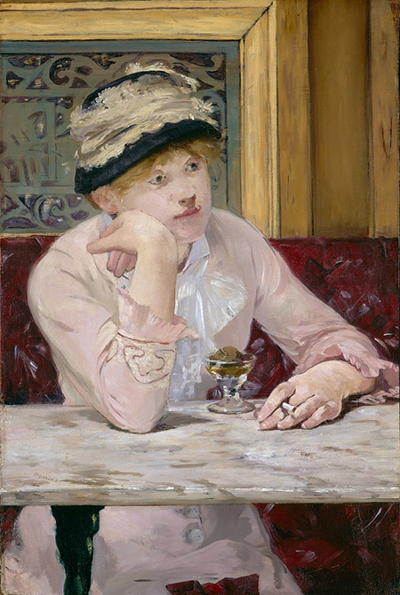Plum Brandy, also known as The Plum is typically Manet.
Likely to have been painted in 1877, the oil on canvas offers the viewer an image of a young lady (modelled by French Actress Ellen Andrée) to study and ponder. For what reason is this young lady alone in a cafe, with her plum brandy, looking so deeply pensive? Plum Brandy was the first of Manet's many paintings depicting a cafe scene. It is thought that the cafe portrayed in the painting is the Café de la Nouvelle, a frequent haunt of Manet.
Upon closer inspection however, the decor does not correspond with other illustrations of the cafe at the time. Therefore, it was likely painted in his own studio, in which he kept a marble table, typical of those used in French cafes during this period. The painting style is simplistic yet modern for the time. Indeed, Manet during these years was beginning to influence younger artists, those that would go on to group under the collective name of "impressionists". The paint is applied in 'dabs' or 'blotches', particularly the plum itself and the left hand belonging to the lady. Whilst the painting style remains simplistic, the image itself invites complex thoughts and questions; namely who is the lady and why is she there?
The location and her demeanour suggest that she is a working girl. Some critics surmise that she is a prostitute, though her clothes would suggest otherwise. Therefore, the consensus lies with the idea that she is a shop worker, lonely and seeking company. It is worth noting that the plum is untouched and the cigarette is unlit, suggesting that she is too deep in thought to pursue the consumption of her purchases. However, as a point of interest, Plum Brandy was thought to have been painted in response to Edgar Degas's L'Absinthe (also modelled by Ellen Andrée). There was also Manet's own Absinthe Drinker.
L'Absinthe really is all about despair, isolation and loneliness, a common theme in 17th Century France. Plum Brandy, on the other hand, has been said to suggest that there is hope, that the lady is hopeful of or expecting company. Of course, we do not know whether she is to be joined in company or not. This is something to continue to ponder over and thousands can and still do as the painting is considered as one of Manet's most major works and has been proudly displayed at The National Gallery of Art, Washington DC since 1971.




